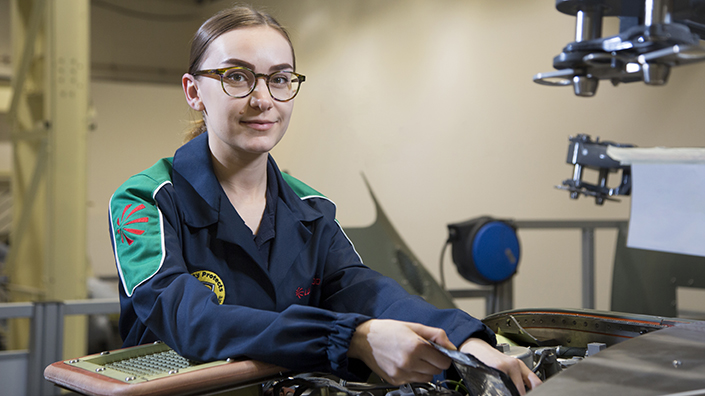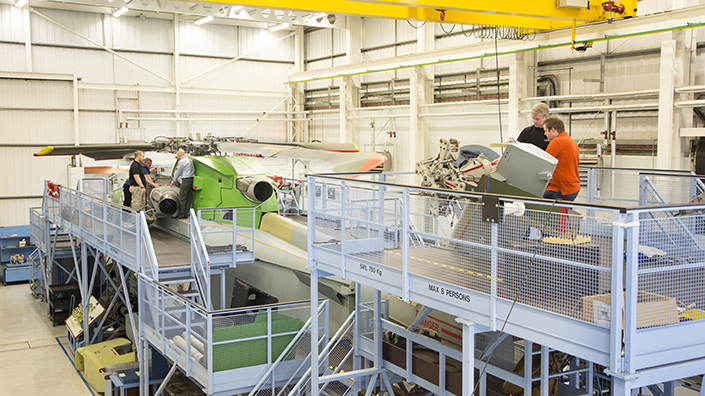Considering what they are capable of, there is little doubt that rotorcraft are extremely complex machines to develop.
Mike Overd, chief engineer for military aircraft UK at Leonardo Helicopters, explains: “Helicopters are subject to so many forces and aerodynamic effects. Take one of these, a phenomenon known as pitch up. As the aircraft moves from the hover into forward flight, the wake from the main rotor hits the horizontal tail. At quite a narrow speed range this suddenly causes the nose of the helicopter to pitch up.
“It can happen almost without warning, which adds stress on the pilots, and so we have to come up with aerodynamic solutions to prevent that.”
Referring to itself as the home of British helicopters, Leonardo Helicopters UK has a history that dates back more than 105 years. During this time, and as a result of several mergers, its name has changed from Westland Helicopters to AgustaWestland and most recently to Leonardo Helicopters in 2016 when it merged with the Italian-owned Leonardo Group, which specialises in aerospace, defence and security.
As helicopters are such complex machines, there is obviously an awful lot that goes into their design, development and manufacture, and Leonardo offers this full end-to-end capability at its UK headquarters in Yeovil, Somerset. Across 220 acres this vast site provides all the skills, technologies and facilities to enable a helicopter to progress from an initial idea through to the finished machine, which then takes off from the runway and is delivered to the customer. The worldwide fleet is also supported from this site, which also houses training facilities for customers and crews.
Leonardo’s helicopters are deployed in more than 150 countries for a range of missions, from defence to emergency and rescue. The company is also one of the biggest suppliers of equipment to the UK Ministry of Defence.
Indeed, Leonardo has recently put forward its latest multi-role military helicopter, AW149, for the MOD’s New Medium Helicopter requirement, which will see the replacement of the RAF’s Puma fleet as well as other helicopter types.
If Leonardo is successful in this bid, it has an established supply chain and will install an additional final assembly line for the platform in Yeovil. The platform is currently assembled in Vergiate, Italy.
Development takes skill
According to independent reviews audited by the likes of Newton Europe, there are 85-89 separate engineering skills needed to design and develop a rotorcraft. But surely some of these skills are present in the development of fixed-wing aircraft? According to Overd, there are fewer transferable skills than you might think.
“Take engine integration, for example,” he says. “The simple answer to why engine integration is unique in a helicopter compared to a fixed wing is how many fixed-wing aircraft do you know that can fly backwards? Flying backwards creates a back pressure up the exhaust pipe that can lead to compressor stall.
“Not only that, the location of the engine, which is mounted above the fuselage, causes challenges in the management of these very hot gases that are stalled when the aircraft is in sideways flight and held against the side of the aircraft. So everything on a helicopter is more difficult.”

The AW149 multi-role craft is the company’s proposal for the UK’s new medium-size military helicopter
The extent of these challenges is something Overd has a great deal of experience in. Having joined Leonardo (or Westland Helicopters as it was known at that time) as an undergraduate as part of his degree course at Brunel University, this will be his 40th year at the company. “I’ve worked in rotorcraft for all my working life but the thing with helicopters is that there’s always a new product, a new technical challenge and something that you’ve never seen before,” he says.
The challenges also extend beyond flight physics and aerodynamics to those around the structural integrity of components, not least of all because rotorcraft have to withstand high-frequency loads and some pretty extreme climatic and environmental conditions. These can range from flying in sub-zero temperatures, strong winds and over rough seas through to scorching temperatures in a desert where sand can cause difficulties not only in terms of erosion but in how it makes its way into the avionics.
Test, test and test again
Faced with all these challenges, key to the design and development process is testing. This testing takes a variety of forms and is done throughout the process. In the initial digital design phase, testing is carried out using aerodynamic and analysis tools to simulate and predict how components and aspects of the rotorcraft will behave.
Overd says: “While we use some vendor-supplied tools like Abacus non-linear finite element analysis software, we’ve also developed our own in-house analytical tools, which are core to our intellectual property and help give us a competitive advantage.”
These aerodynamic models are then prototyped and further tested in the on-site wind tunnel, which is capable of carrying out 1/7th-scale testing.
Another testing capability used as part of the development process is Leonardo’s impressive on-site simulation facility, which consists of several simulator cells. These perform three key roles: use in research and development, as an engineering tool within the main helicopter programmes, and for training customers and crews.
Cockpit simulation
One of these simulator cells is currently configured as an AW101 Merlin Mark 4, which is being used to train aircrew. It consists of a high-fidelity, ergonomic representation of the cockpit with a projection system that inserts the cockpit into a realistic environment with representative force feedback provided through the controls.
Edward Goddard, head of mission management systems at Leonardo, says: “Our aim is for aircrew to step out of a Merlin on the runway and into our simulator and not question that it’s the same aircraft. Just a few weeks ago, we had our test pilots in here flying the Merlins onto the Royal Navy’s aircraft carrier HMS Queen Elizabeth, which is the first time that’s happened in the UK.”
Overd adds: “The simulation is able to predict the complex environment on a ship that is caused by wind blowing over it, known as the air wake. The aircrew flying the simulator are then able to determine how difficult it is to land on these ship types during certain wind and sea conditions. It’s a true flight-physics simulation of that problem.”

Leonardo offers a variety of apprenticeships covering hardware and software engineering, business and cyber security
The second simulator cell is set up as an AW159 Wildcat configuration. Although it is now being used for aircrew training, it was also extensively used during the early stages of the aircraft’s development, in the design of all the display human-machine interfaces (HMIs).
Goddard says: “We’ve had engineers, the customer and crews sat in this simulator providing feedback on the various interfaces and symbols that make the mission system come to life. It was an iterative approach to ensure we provided a really high-quality HMI that enables crew to make operation decisions quickly and effectively.” This simulation capability provides vast benefits as part of the development process. The vision, as Goddard says, is to further expand the use of these synthetic environments to the point where they can be used for trials evaluations, and so reducing the amount of real-world trials needed.
Prediction v reality
From a synthetic environment we go into the physical, hands-on environment of the Structural Test Laboratory. This large facility is dedicated to the structural testing of various aircraft components, which is crucial in the development of helicopters owing to the enormous loads they are subjected to.
Matt Goodwin, chief structural test engineer at Leonardo, explains: “In our lab we set up rigs together with the design of data acquisition systems and then apply specific sets of loads to a component. This helps us understand the life of that component under different flight loads.
“The aim is to catch a failure early before we get complete failure of the component. And while tools are good the reality is that we still get failures that were not predicted or expected. But also we want to get failures to make sure that the prediction models are correct.”
The rigs can be pretty substantial. One that has been running in the lab for a number of years weighs 30 tonnes and the component it is testing weighs just 28kg. “It’s a complicated test because we’re applying many tonnes of load to the component in three directions as well as twisting and bending it,” says Goodwin.

Leonardo has the full range of facilities needed to develop and test rotary-wing aircraft
For Overd, this department truly highlights the benefit of having an end-to-end capability on site that allows for very short lines of communication between the manufacture of the part and the team designing that part. “Due to the challenges faced in making practical solutions to the rotary problem, having this iterative development loop that enables changes and further testing is crucial,” he says.
Once the aircraft is built, testing continues, as additional problems may only arise in flight. As part of the test campaign, the aircraft is covered in strain gauges and other sensors and, while the test pilots are in the air, engineers in the telemetry ground station are monitoring the aircraft.
Overd says: “We have a big team of very experienced test pilots that are linked to our development engineers. This physical flight testing will confirm whether all our analysis does indeed correlate with the actual measured behaviour. Hopefully it does but if not then, again, we’ve got that iterative loop between testing and modelling that enables us to close that gap.”
Leonardo has recently been on a recruitment drive, expanding its team of engineers from 470 to 515. The reason for this, according to Overd, is the confidence the group has in the future of the Yeovil capability. This future capability will not only involve developing rotorcraft that can travel further and carry heavier loads but will also involve further investigation into remotely-piloted and autonomous/semi-autonomous systems as well as the use of hybrid electric power plants.
Hybrids on the horizon
“At Leonardo we are committed to exploring hybrid power. It will provide many opportunities, for instance the move towards more multi-rotor configurations. But there are challenges that come with it, including how to distribute power and how to control the electric motors,” he says.
With the Leonardo Group looking to Yeovil to take a lead on hybrid power, this is no small endeavour. It will require much exploration and research because, as Overd makes apparent, everything on a helicopter is that bit more difficult.
Get to grips with the future factory at Advanced Manufacturing (18-22 July), part of the Engineering Futures webinar series. Register for FREE today.
Content published by Professional Engineering does not necessarily represent the views of the Institution of Mechanical Engineers.